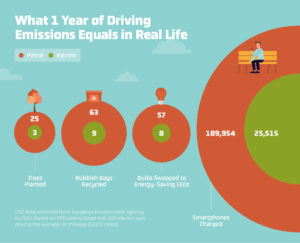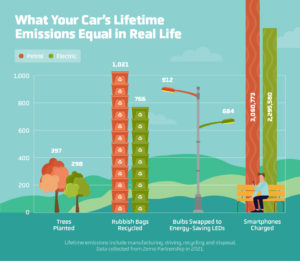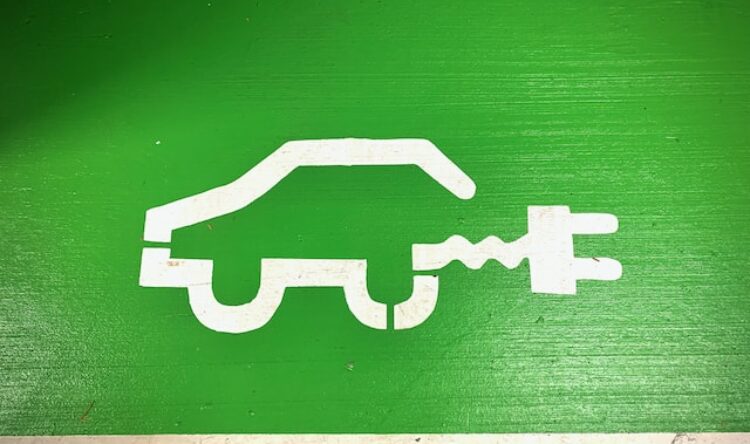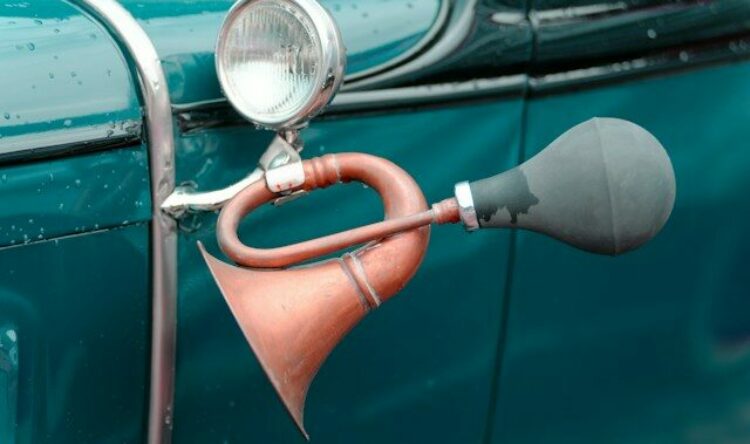What your car’s emissions look like
Petrol Vs Electric: visualising real life emissions
With electric vehicles being heralded as the clean future of motoring, how o they really compare to the traditional combustion engined versions?
Moneyshake compares the CO2 emissions of 100 petrol/diesel and 100 electric cars in an attempt to show real life realities. For example, how many trees you’d need to plant to offset your car’s emissions? How many smartphones could be charged?
1 in 4 drivers don’t believe electric cars are more environmentally friendly than driving petrol or diesel vehicles, according to a recent study. But with the upcoming 2030 deadline to make the switch, drivers have no other option than to choose an electric vehicle (EV). If you’re having doubts about the eco-friendliness of driving an electric car, Moneyshake crunched the numbers to see how they compare to traditional fuels.
Key Findings:
● Petrol/diesel cars emit 7x more emissions than electric – You’d need to plant 25 trees in a year if you use a petrol/diesel car to offset your annual emissions. If you switch to electric, you’d only need to plant three. Meanwhile, 190k smartphones could be charged from the annual emissions of a petrol/diesel car.
● A petrol car’s life cycle produces the same emissions as 3 million smartphones
● 250,000 smartphones produce the same emissions as a Volkswagen Golf
● Driving a petrol/diesel car for a year is equal to 63 rubbish bags going to landfill. This is only 9 for an electric, or 0 if you drive a BEV (Battery Electric Vehicle). Looking at it another way, 912 bulbs would need to be swapped to energy-saving LEDs to offset the emissions of your petrol/diesel car over its lifetime.
Petrol/diesel cars emit 7x more emissions than electric
Analysing the CO2 emissions of most popular petrol/diesel and electric cars (vehicles registered by the Department for Transport between 2015 and 2020), the average CO2 emissions of a petrol/diesel vehicle are seven times higher than electric.
The top petrol/diesel cars emit 1.4 million grams of CO2 per year if you drive the UK on average of 7,400 miles annually. This compares to 200,000 grams of CO2 emissions per year if you drive a hybrid or plug-in vehicle.
What 1 year of driving emissions equals in real life – petrol vs. electric

If you drive a Ford Fiesta, Vauxhall Corsa or Volkswagen Golf, you’re at the wheel of one of the most popular cars. But the CO2 emitted by these cars is the equivalent of charging a huge 189,954 smartphones.
This compares to just 25,515 if you drive an EV, including the most popular models such as the Mitsubishi Outlander PHEV, BMW 330e or Tesla Model S.
What’s more, to offset the CO2 emissions of the average popular petrol/diesel car, you’d need to plant 25 trees in a year. If you switch to electric, you’d only need to plant three.
A petrol car’s life cycle produces the same emissions as 3 million smartphones
Even drivers who know electric cars are more eco-friendly than petrol or diesel vehicles still have doubts, due to emissions from EV production.
While a battery-electric vehicle (BEV) has zero tailpipe emissions, there are emissions produced in the manufacturing process. Almost half (46%) of an EV’s total carbon footprint is generated by the manufacturing process.
However, when comparing the total amount of CO2 created by cars over their life cycle, including manufacturing, driving, recycling and disposal, electric still comes out on top. According to a report by Zemo Partnership, petrol cars produce around 24 tonnes of CO2 during their lifetime, whereas an electric vehicle emits 25% less. But what does that equate to in real life?
250,000 smartphones produce the same emissions as a Volkswagen Golf
Data reveals that the VW Golf emits the most CO2 on average, out of the most popular cars analysed – around 165 g/km. These emissions are equivalent to charging almost 250,000 smartphones. This is three times more than the highest emissions EV, the BMW 530e. With average CO2 emissions of 47 g/km, the hybrid’s emissions are equal to 71,868 smartphones charged.
Here are some smartphone charging comparisons for petrol/diesel, hybrids and EVs:
| Top 10 Petrol/Diesel Models | No. of Smartphones Charged Equal to CO2 Emissions | Top 10 EV Models | No. of Smartphones Charged Equal to CO2 Emissions |
| Volkswagen Golf | 249,991 | BMW 530e | 71,686 |
| BMW 3 Series | 206,554 | Volkswagen Golf GTE | 64,396 |
| Vauxhall Astra | 205,339 | Mitsubishi Outlander PHEV | 60,751 |
| Ford Focus | 201,998 | BMW 330e | 58,321 |
| Vauxhall Corsa | 193,037 | Nissan Leaf | 0 |
| Ford Fiesta | 183,621 | BMW i3 | 0 |
| Nissan Qashqai | 182,102 | Renault Zoe | 0 |
| Toyota Yaris | 161,295 | Tesla Model S | 0 |
| Volkswagen Polo | 158,257 | Tesla Model 3 | 0 |
| Renault Clio | 157,346 | Tesla Model X | 0 |
150 trees need to be planted to offset the emissions of your petrol/diesel car
On average, petrol/diesel drivers would need to plant 25 trees a year to offset their CO2 emissions. It’s said that we keep our cars for around six years, making a total of 150 trees that you’d need to plant.
Compare that to the electric average, which is just three trees, totalling 18 for the average time you’d keep the car – that’s much less than traditional fuels.
Here’s how many trees you’d need to plant per car, per year:
| Top 10 Petrol/Diesel Models | No. of Trees Planted to Offset CO2 Emissions | Top 10 EV Models | No. of Trees Planted to Offset CO2 Emissions |
| Volkswagen Golf | 32.4 | BMW 530e | 9.3 |
| BMW 3 Series | 26.8 | Volkswagen Golf GTE | 8.3 |
| Vauxhall Astra | 26.6 | Mitsubishi Outlander PHEV | 7.9 |
| Ford Focus | 26.2 | BMW 330e | 7.6 |
| Vauxhall Corsa | 25.0 | Nissan Leaf | 0 |
| Ford Fiesta | 23.8 | BMW i3 | 0 |
| Nissan Qashqai | 23.6 | Renault Zoe | 0 |
| Toyota Yaris | 20.9 | Tesla Model S | 0 |
| Volkswagen Polo | 20.5 | Tesla Model 3 | 0 |
| Renault Clio | 20.4 | Tesla Model X | 0 |
Driving a petrol/diesel car for a year is equal to 63 rubbish bags going to landfill
The research shows that, on average, petrol/diesel drivers would need to recycle 63 rubbish bags, instead of them going to landfill, to avoid the CO2 emissions emitted by their car. The VW Golf is again the highest, equal to 83 bags of rubbish, followed by the BMW 3 Series at 69.
For electric cars, you’d only need to recycle an average of nine rubbish bags instead of taking them to landfill, or none at all if you drive a BEV, which is zero emissions.
Offset emissions of petrol/diesel cars by swapping 57 bulbs
If you wanted to avoid the amount of CO2 emitted by a petrol/diesel car, you’d need to swap 57 regular incandescent bulbs for energy-efficient LED alternatives. However, you’d only need to swap 8 bulbs if you drive electric, or none if you drive a BEV.
Out of the most popular cars analysed, the VW Golf has the highest CO2, resulting in you needing to swap 75 bulbs to avoid emissions. Compare that to the highest EV, the BMW 530e plug-in at just 21 bulbs. It goes to show that you don’t need an all-electric vehicle to be more eco-friendly, hybrids are better too.








